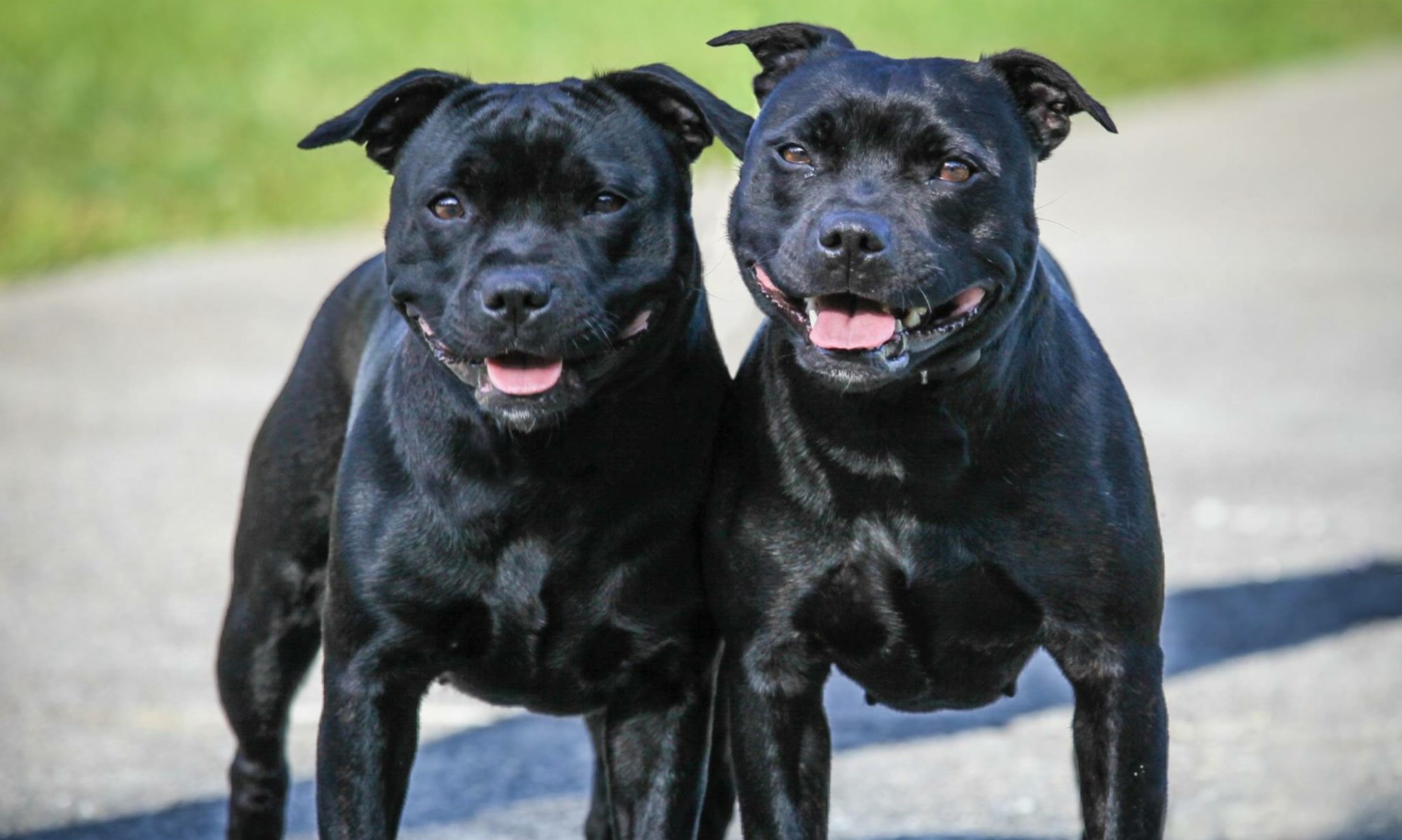I see a lot of people new to the world of Staffords say that they are looking for a ‘blue’ and asking how to find one from a good breeder. Although I have addressed this topic several times in my blog the posts do tend to get lost over time so let me discuss this again.
First of all – there is absolutely nothing wrong with having a color preference when looking for a pet. In Staffords we will often, mostly, see breeders who only own reds or only piebalds or only brindle/black brindle. Its normal to have preferences.
Second, when seeking a new Stafford puppy no matter what color you are thinking about buying color and price should be the last part of the equation but its usually first thing we hear asked about. Again, normal – this is mainly due to not understanding genetics and responsible breeding. Usually, once a new buyer learns the differences in how different breeders operate they know better what to look for and what is a red flag to run from.
I also understand that just like there are varying types of breeders, there also are varying types of buyers. Some just want to send money and get a puppy like an Amazon order. Tell the breeder what color, sex and price you are willing to pay and send your deposit – then receive your puppy. It is my very strong opinion this is a horrible way to buy an animal which will be living with you for hopefully up to 16+ years.
So here is some more information – take it for what its worth – My opinions are based upon 19+ years of helping with Stafford rescue, owning, breeding, studying the breed and mentoring others. What I am about to say is just my understanding and my views based upon my personal experiences. Your mileage may vary.
When looking for a Stafford look for a breeder whom you can trust, who will offer support and mentorship and who is not just simply paying their bills by making puppies. Its pretty easy to get around a slick website just with a phone call, but if you still aren’t sure ask them some questions or send an introductory email. There is a popular list of ten essential questions to ask but really – make a list of issues important to you and ask. You are interviewing the breeder as much as they are interviewing you. At least – there SHOULD be interviewing going on. If not and all you get is – send a deposit – IMO that’s a red flag folks. You may want to look at what health testing is being done. Possibly look at how they raise their own dogs. You might wish to see living conditions where their dogs live and where puppies are raised. Perhaps have a look at how involved they are in the Stafford community. Mostly – read the contracts you are required to sign. Are you okay with a strict contract or are you seeking a no strings attached sale? We are all okay with different agreements. Just be comfortable with your purchase.
The main thing to concern yourself about as far as wanting a blue Stafford is this – is the breeder producing blue on purpose? Are they putting two blue parents together knowing they will get blue puppies? Is the only color they produce blue? Is every single litter all blue or blue/white? What do their dogs look like? Do they look the same as the brindles or reds or piebalds you see on the internet from breeders you think are responsible people? Do they look like Staffords? Are you being fed lines about how they are producing ‘leggier/sporty/champion pedigrees’ or any other marketing flash? Are they more concerned about selling puppies than they are about getting to know you and how their puppy will live?
Unlike when a breeder mates two reds or two black brindles, when two blues are put together this is purposeful dilute combination breeding. This is breeding for a specific market instead of breeding for the whole dog. Breeding should be done carefully with much attention focused on health, temperament, structure, type and more. It should NOT be only about the color! Breeding only red or black brindle or white is an entirely different conversation – and (except for all white) usually doesn’t have the health issues which continuously mating blue to blue only has. They will insist this is not true. They will insist their blues have no health or temperament issues. Ask to see examples of DCA or unstable temperaments. See if they respond with an honest answer. Dilute Color Alopecia is possible in any dilute animal but mostly in generationally produced dilutes.
Consider this – if you take a glass of iced tea and mix it with the same volume of plain water you now have 50% tea, 50% water (the water representing dilute). Now take that mix and again mix with a glass of plain water. Now you have 75% water and 25% tea. Take this mix and again combine with plain water. At what point are you simply mixing water with water with zero amount of iced tea? Do you see what I am getting at? Now of course this is a highly simple example of how dilute to dilute genetics works and I don’t mean to be condescending at all but it also cannot be ignored. You lose type, temperament, stability – you don’t really know what you have since this is a dilute gene, which acts differently from a non dilute genetic mix.
Putting two dilute affected dogs together can only produce dilute affected dogs. What’s wrong with dilute to dilute you ask? Genetically, its rather complicated and can possibly lead to many long term issues, but the easy answer is dilute to dilute is furthering the dilutions causing other problems to arise such as allergy problems, coat breakage, coat thinning, alopecia, blowing coat, lacking breed type, lacking pigment, losing eye/nose/pad color and when done often enough the lack of breed type extends to temperament as well. We (rescue around the world) have seen ‘Staffords’ from long lines of dilute to dilute who are not as stable in temperament as the Stafford has always been known for. This is not a good thing. We see yellow eyes, bad feet, fleshy muzzles, fear aggression, shyness and other problems which seem to appear more often in these blue to blue produced Staffords. I can’t explain this scientifically but I have observed it. So that blue Stafford breeder who is telling you this cannot be true – well, they simply haven’t seen it but we have.
If a breeder is putting two brindles together and they get a blue puppy that’s completely different. If a breeder owns a blue bitch and puts her to a brindle/black brindle dog the responsible thing to do is coat color DNA testing (now that this tool is available) to make sure that dog is not a dilute carrier. A black brindle dog who is a carrier should ideally only be used on a bitch who is not a carrier, and vice versa. These combinations are not as much of a health risk as continuous blue to blue, in my opinion. I bred my brindle bitch to a brindle dog who was known to have produced a dilute in the past. This was prior to coat color DNA testing being available. Instead I, and my mentors, researched pedigrees and we went back 9 generations without finding evidence of a blue puppy. We felt safe. Guess what we got? Two blue puppies! It happens. I kept one and I sold one. He was sold on a no breeding contract. My blue bitch was only bred to non dilute carriers and only produced brindle and black brindle. She also has a very different coat from the non dilutes we own. Her coat breaks easily, gets bleached in the sun easily and she blows her coat something fierce twice a year! Currently she is so bald I have to use sunscreen on her. The coat will come back and it will look beautiful and dark again, but I mention this b/c it is different from her non dilute family members. (*UPDATE* – once she was spayed her thinning coat never came back fully so it is linked to hormones as well which could explain the temperament issues we have seen in generationally produced blue to blue Staffords in rescue). We simply do not know enough genetically speaking about dilute to dilute breeding to have all the answers.
The argument put forth by the masses is that breeders purposefully breeding blue to blue to blue to blue are only in it for the money. Sure, I would agree, no doubt this is the case – however – many breeders who only breed red to red, black brindle to black brindle, piebald to piebald can essentially be guilty of this as well so that argument fails for me. For me its more a matter of preserving the breed in ALL aspects. There are bad breeders of all colors and types. I know of some horrific situations coming out of kennels of colors other than just blue from my time helping rescue and also what I have observed in the show world. There are some excellent very slick and shiny fancy salespeople out there. Do your homework. If you insist you ONLY want a blue Stafford puppy – thats fine too – let a reputable breeder help you locate one from another responsible breeder who just happened to get some blue ones in a litter of non dilute puppies. Same rules apply – be comfortable with what you buy.
All I am saying here is STOP looking for your puppy and START looking for your breeder.

